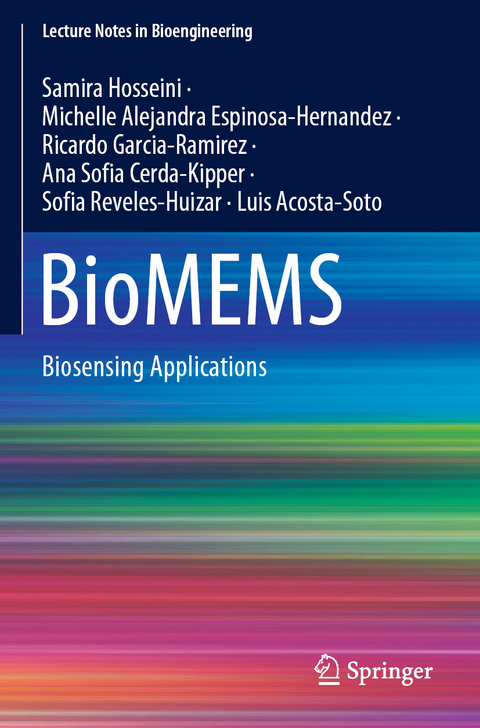
BioMEMS
Springer Verlag, Singapore
978-981-15-6384-3 (ISBN)
Samira Hosseini obtained her B.Sc. degree in Applied Physics from the University of North Tehran, Iran, and her M.Sc. degree in Polymer Chemistry and a Ph.D. degree in Biomedical Engineering from the University of Malaya, Kuala Lumpur, Malaysia. She served as a postdoctoral associate at Tecnologico de Monterrey, Mexico, while holding a postdoctoral fellowship at Massachusetts Institute of Technology, Cambridge, USA. Currently, she is Director of Writing Lab in the Center for Educational Innovation at Tecnologico de Monterrey, Mexico. She also holds the position of research professor at the School of Engineering and Sciences, Tecnologico de Monterrey. She is the author/co-author of more than 30 scientific publications and 19 book chapters and is the inventor/co-inventor of 6 intellectual properties. Samira is the recipient of the Hero of the Year award for her outstanding achievements at Writing Lab. Moreover, two intellectual properties lead by her research team were selected forthe Best Invention of the Year award. She is a member of the Mexican National Academy of Researchers (level one) and is on the editorial board of different international journals. Michelle is a biomedical engineering student at the Tecnologico de Monterrey while obtaining her Master's degree, simultaneously, in Intelligent Systems and Robotics at the University of Essex in the UK. She was a member of the Biomedical Engineering Society as well as the Academic Society for Science and Engineering. She is the co-author of an extensive review article in the area of tissue engineering. Ricardo received his Bachelor’s degree in Biomedical Engineering with specialization in biomedical microtechnologies from Tecnologico de Monterrey, Monterrey, Mexico, in 2019. He has worked as a Research Assistant at the Biomedical Engineering Lab at Tec de Monterrey and has participated in research internship programs in the Elvira Lab at the University ofVictoria, Victoria, Canada, as well as in Sensors Lab at King Abdullah University of Science and Technology (KAUST), Thuwal, Saudi Arabia. Ana Sofia obtained her Bachelor’s degree in Engineering in Biotechnology from Tecnologico de Monterrey, Mexico. She is currently finalizing her Master’s degree in Business Management (MBM) at EGADE of Tecnologico de Monterrey, Monterrey, Mexico. She was a member of FEMSA laboratory and has worked at Writing Lab as Assistant Director. She has also participated as coordination staff of the International Congress of Innovation Education (CIIE) and in INCmty for two consecutive years. She is the principal author of a chapter of the Encyclopedia of Analytical Science, second edition, which was published by Elsevier in 2018. She is actively collaborating in research and writing of several projects. Ana is currently working on Accenture in the Skin Cancer Solution Project. Sofia is a Biomedical Engineer with specialty of Biomedical Microtechnology within Tecnologico de Monterrey, Monterrey, Mexico. Sofia has worked as a Research Assistant at the Brain, Language and Cognition Lab at the University of Texas in San Antonio, USA, and has experience in Clinical Engineering field. She is currently working as a Senior Research Assistant at Writing Lab and is involved in various research projects in the field of Biomedical Engineering. Luis is a Biomedical Engineering student at Tecnologico de Monterrey, Monterrey, Mexico. Luis has collaborated in the design of casting orthosis alternatives at Wavebiomedics. He is part of the student board of Biomedical Engineering Society and an active member of the International Genetically Engineered Machine chapter. Luis is the co-author of an extensive review article recently accepted by Lab-on-chip journal.
History of Bio-microelectromechanical systems (BioMEMS).- Bio-microelectromechanical systems (BioMEMS) in Bio-sensing applications-Colorimetric detection strategies.- Bio-microelectromechanical systems (BioMEMS) in Bio-sensing applications-Fluorescence detection strategies.- Bio-microelectromechanical systems (BioMEMS) in Bio-sensing applications-Luminescence detection strategies.- Bio-microelectromechanical systems (BioMEMS) in Bio-sensing applications-Bioluminescence detection strategies.- Bio-microelectromechanical systems (BioMEMS) in Bio-sensing applications-Chemiluminescence detection strategies.- Bio-microelectromechanical systems (BioMEMS) in Bio-sensing applications-Biochemiluminescence detection strategies.- Bio-microelectromechanical systems (BioMEMS) in Bio-sensing applications-Electrochemiluminescence detection strategies.
| Erscheinungsdatum | 31.08.2021 |
|---|---|
| Reihe/Serie | Lecture Notes in Bioengineering |
| Zusatzinfo | 57 Illustrations, color; 4 Illustrations, black and white; XV, 178 p. 61 illus., 57 illus. in color. |
| Verlagsort | Singapore |
| Sprache | englisch |
| Maße | 155 x 235 mm |
| Themenwelt | Medizin / Pharmazie ► Physiotherapie / Ergotherapie ► Orthopädie |
| Naturwissenschaften ► Physik / Astronomie ► Atom- / Kern- / Molekularphysik | |
| Naturwissenschaften ► Physik / Astronomie ► Festkörperphysik | |
| Naturwissenschaften ► Physik / Astronomie ► Thermodynamik | |
| Technik ► Maschinenbau | |
| Technik ► Medizintechnik | |
| Schlagworte | Biochemiluminescence • Bioluminescence • Chemiluminescence • colorimetric detection • Drug Delivery • Electrochemiluminescence • Fluorescence Detection • implantable devices • lab-on-chip (LOC) • Luminescence detection • Tissue engineering |
| ISBN-10 | 981-15-6384-5 / 9811563845 |
| ISBN-13 | 978-981-15-6384-3 / 9789811563843 |
| Zustand | Neuware |
| Haben Sie eine Frage zum Produkt? |
aus dem Bereich


